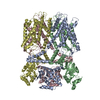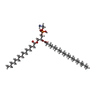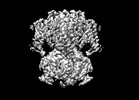[English] 日本語
 Yorodumi
Yorodumi- EMDB-31532: Cryo-EM structure of the Potassium channel AKT1 mutant from Arabi... -
+ Open data
Open data
- Basic information
Basic information
| Entry |  | |||||||||
|---|---|---|---|---|---|---|---|---|---|---|
| Title | Cryo-EM structure of the Potassium channel AKT1 mutant from Arabidopsis thaliana | |||||||||
 Map data Map data | ||||||||||
 Sample Sample |
| |||||||||
 Keywords Keywords | Complex / Potassium channel / Membrane protein / PLANT PROTEIN | |||||||||
| Function / homology |  Function and homology information Function and homology informationroot hair elongation / regulation of stomatal closure / response to water deprivation / inward rectifier potassium channel activity / monoatomic ion channel complex / potassium ion import across plasma membrane / response to salt stress / potassium ion transport / identical protein binding / plasma membrane Similarity search - Function | |||||||||
| Biological species |  | |||||||||
| Method | single particle reconstruction / cryo EM / Resolution: 2.9 Å | |||||||||
 Authors Authors | Yang GH / Lu YM | |||||||||
 Citation Citation |  Journal: Nat Commun / Year: 2022 Journal: Nat Commun / Year: 2022Title: Structural basis for the activity regulation of a potassium channel AKT1 from Arabidopsis. Authors: Yaming Lu / Miao Yu / Yutian Jia / Fan Yang / Yanming Zhang / Xia Xu / Xiaomin Li / Fan Yang / Jianlin Lei / Yi Wang / Guanghui Yang /  Abstract: The voltage-gated potassium channel AKT1 is responsible for primary K uptake in Arabidopsis roots. AKT1 is functionally activated through phosphorylation and negatively regulated by a potassium ...The voltage-gated potassium channel AKT1 is responsible for primary K uptake in Arabidopsis roots. AKT1 is functionally activated through phosphorylation and negatively regulated by a potassium channel α-subunit AtKC1. However, the molecular basis for the modulation mechanism remains unclear. Here we report the structures of AKT1, phosphorylated-AKT1, a constitutively-active variant, and AKT1-AtKC1 complex. AKT1 is assembled in 2-fold symmetry at the cytoplasmic domain. Such organization appears to sterically hinder the reorientation of C-linkers during ion permeation. Phosphorylated-AKT1 adopts an alternate 4-fold symmetric conformation at cytoplasmic domain, which indicates conformational changes associated with symmetry switch during channel activation. To corroborate this finding, we perform structure-guided mutagenesis to disrupt the dimeric interface and identify a constitutively-active variant Asp379Ala mediates K permeation independently of phosphorylation. This variant predominantly adopts a 4-fold symmetric conformation. Furthermore, the AKT1-AtKC1 complex assembles in 2-fold symmetry. Together, our work reveals structural insight into the regulatory mechanism for AKT1. | |||||||||
| History |
|
- Structure visualization
Structure visualization
| Supplemental images |
|---|
- Downloads & links
Downloads & links
-EMDB archive
| Map data |  emd_31532.map.gz emd_31532.map.gz | 88.6 MB |  EMDB map data format EMDB map data format | |
|---|---|---|---|---|
| Header (meta data) |  emd-31532-v30.xml emd-31532-v30.xml emd-31532.xml emd-31532.xml | 10.1 KB 10.1 KB | Display Display |  EMDB header EMDB header |
| Images |  emd_31532.png emd_31532.png | 65.4 KB | ||
| Filedesc metadata |  emd-31532.cif.gz emd-31532.cif.gz | 5.4 KB | ||
| Archive directory |  http://ftp.pdbj.org/pub/emdb/structures/EMD-31532 http://ftp.pdbj.org/pub/emdb/structures/EMD-31532 ftp://ftp.pdbj.org/pub/emdb/structures/EMD-31532 ftp://ftp.pdbj.org/pub/emdb/structures/EMD-31532 | HTTPS FTP |
-Related structure data
| Related structure data |  7fcvMC  7wswC  7xufC M: atomic model generated by this map C: citing same article ( |
|---|---|
| Similar structure data | Similarity search - Function & homology  F&H Search F&H Search |
- Links
Links
| EMDB pages |  EMDB (EBI/PDBe) / EMDB (EBI/PDBe) /  EMDataResource EMDataResource |
|---|---|
| Related items in Molecule of the Month |
- Map
Map
| File |  Download / File: emd_31532.map.gz / Format: CCP4 / Size: 125 MB / Type: IMAGE STORED AS FLOATING POINT NUMBER (4 BYTES) Download / File: emd_31532.map.gz / Format: CCP4 / Size: 125 MB / Type: IMAGE STORED AS FLOATING POINT NUMBER (4 BYTES) | ||||||||||||||||||||
|---|---|---|---|---|---|---|---|---|---|---|---|---|---|---|---|---|---|---|---|---|---|
| Voxel size | X=Y=Z: 1.0825 Å | ||||||||||||||||||||
| Density |
| ||||||||||||||||||||
| Symmetry | Space group: 1 | ||||||||||||||||||||
| Details | EMDB XML:
|
-Supplemental data
- Sample components
Sample components
-Entire : Arabidopsis thaliana Potassium channel AKT1
| Entire | Name: Arabidopsis thaliana Potassium channel AKT1 |
|---|---|
| Components |
|
-Supramolecule #1: Arabidopsis thaliana Potassium channel AKT1
| Supramolecule | Name: Arabidopsis thaliana Potassium channel AKT1 / type: complex / ID: 1 / Parent: 0 / Macromolecule list: #1 |
|---|---|
| Source (natural) | Organism:  |
-Macromolecule #1: Potassium channel AKT1
| Macromolecule | Name: Potassium channel AKT1 / type: protein_or_peptide / ID: 1 / Number of copies: 4 / Enantiomer: LEVO |
|---|---|
| Source (natural) | Organism:  |
| Molecular weight | Theoretical: 97.065609 KDa |
| Recombinant expression | Organism:  |
| Sequence | String: MRGGALLCGQ VQDEIEQLSR ESSHFSLSTG ILPSLGARSN RRVKLRRFVV SPYDHKYRIW EAFLVVLVVY TAWVSPFEFG FLRKPRPPL SITDNIVNAF FAIDIIMTFF VGYLDKSTYL IVDDRKQIAF KYLRSWFLLD LVSTIPSEAA MRISSQSYGL F NMLRLWRL ...String: MRGGALLCGQ VQDEIEQLSR ESSHFSLSTG ILPSLGARSN RRVKLRRFVV SPYDHKYRIW EAFLVVLVVY TAWVSPFEFG FLRKPRPPL SITDNIVNAF FAIDIIMTFF VGYLDKSTYL IVDDRKQIAF KYLRSWFLLD LVSTIPSEAA MRISSQSYGL F NMLRLWRL RRVGALFARL EKDRNFNYFW VRCAKLVCVT LFAVHCAACF YYLIAARNSN PAKTWIGANV ANFLEESLWM RY VTSMYWS ITTLTTVGYG DLHPVNTKEM IFDIFYMLFN LGLTAYLIGN MTNLVVHGTS RTRNFRDTIQ AASNFAHRNH LPP RLQDQM LAHLCLKYRT DSEGLQQQET LDALPKAIRS SISHFLFYSL MDKVYLFRGV SNALLFQLVS EMKAEYFPPK EDVI LQNEA PTDFYILVNG TADLVDVDTG TESIVREVKA GDIIGEIGVL CYRPQLFTVR TKRLCQLLRM NRTTFLNIIQ ANVGD GTII MNNLLQHLKE MNDPVMTNVL LEIENMLARG KMDLPLNLCF AAIREDDLLL HQLLKRGLDP NESDNNGRTP LHIAAS KGT LNCVLLLLEY HADPNCRDAE GSVPLWEAMV EGHEKVVKVL LEHGSTIDAG DVGHFACTAA EQGNLKLLKE IVLHGGD VT RPRATGTSAL HTAVCEENIE MVKYLLEQGA DVNKQDMHGW TPRDLAEQQG HEDIKALFRE KLHERRVHIE TSSSVPIL K TGIRFLGRFT SEPNIRPASR EVSFRIRETR ARRKTNNFDN SLFGILANQS VPKNGLATVD EGRTGNPVRV TISCAEKDD IAGKLVLLPG SFKELLELGS NKFGIVATKV MNKDNNAEID DVDVIRDGDH LIFATDS UniProtKB: Potassium channel AKT1 |
-Macromolecule #2: PHOSPHATIDYLETHANOLAMINE
| Macromolecule | Name: PHOSPHATIDYLETHANOLAMINE / type: ligand / ID: 2 / Number of copies: 4 / Formula: PTY |
|---|---|
| Molecular weight | Theoretical: 734.039 Da |
| Chemical component information |  ChemComp-PTY: |
-Macromolecule #3: POTASSIUM ION
| Macromolecule | Name: POTASSIUM ION / type: ligand / ID: 3 / Number of copies: 3 / Formula: K |
|---|---|
| Molecular weight | Theoretical: 39.098 Da |
-Experimental details
-Structure determination
| Method | cryo EM |
|---|---|
 Processing Processing | single particle reconstruction |
| Aggregation state | particle |
- Sample preparation
Sample preparation
| Buffer | pH: 7.4 |
|---|---|
| Vitrification | Cryogen name: ETHANE |
- Electron microscopy
Electron microscopy
| Microscope | FEI TITAN KRIOS |
|---|---|
| Image recording | Film or detector model: GATAN K2 SUMMIT (4k x 4k) / Average electron dose: 1.5625 e/Å2 |
| Electron beam | Acceleration voltage: 300 kV / Electron source:  FIELD EMISSION GUN FIELD EMISSION GUN |
| Electron optics | Illumination mode: FLOOD BEAM / Imaging mode: BRIGHT FIELD |
| Experimental equipment |  Model: Titan Krios / Image courtesy: FEI Company |
- Image processing
Image processing
| Startup model | Type of model: EMDB MAP |
|---|---|
| Final reconstruction | Resolution.type: BY AUTHOR / Resolution: 2.9 Å / Resolution method: FSC 0.143 CUT-OFF / Number images used: 342803 |
| Initial angle assignment | Type: PROJECTION MATCHING |
| Final angle assignment | Type: MAXIMUM LIKELIHOOD |
 Movie
Movie Controller
Controller








